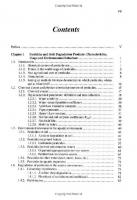Assessment of an ultramicroelectrode array UMEA) sensor for the determination of trace concentrations of heavy metals in water 3937300481, 9783937300481
Bestellen Sie jetzt und wir liefern, sobald der Artikel verfügbar ist. Sie erhalten von uns eine E-Mail mit dem voraussi
299 81 4MB
English Pages 153 Year 2010
Recommend Papers
File loading please wait...
Citation preview
Karlsruher Mineralogische und Geochemische Hefte Schriftenreihe des Instituts für Mineralogie und Geochemie 26
Xudong Xie Assessment of an ultramicroelectrode array (UMEA) sensor for the determination of trace concentrations of heavy metals in water
universitätsverlag karlsruhe
Xudong Xie Assessment of an ultramicroelectrode array (UMEA) sensor for the determination of trace concentrations of heavy metals in water
Karlsruher Mineralogische und Geochemische Hefte Schriftenreihe des Instituts für Mineralogie und Geochemie, Universität Karlsruhe (TH) Band 26
Assessment of an ultramicroelectrode array (UMEA) sensor for the determination of trace concentrations of heavy metals in water von Xudong Xie
Dissertation, Universität Karlsruhe (TH), Fakultät für Bauingenieur-, Geo- und Umweltwissenschaften, 2004
Anschrift des Autors: Xudong Xie Institut für Mineralogie und Geochemie Universität Karlsruhe (TH) D-76128 Karlsruhe
Anschrift der Schriftleitung: Karlsruher Mineralogische und Geochemische Hefte Institut für Mineralogie und Geochemie Universität Karlsruhe (TH) D-76128 Karlsruhe
Impressum Universitätsverlag Karlsruhe c/o Universitätsbibliothek Straße am Forum 2 D-76131 Karlsruhe www.uvka.de Ó Universitätsverlag Karlsruhe 2005 Print on Demand
ISSN 1618-2677 ISBN 3-937300-48-1
Abstract
Abstract Rapid development in silicon technology and microelectronics has nowadays enabled the mass fabrication of microelectrode arrays with well-defined and reproducible geometries on micron scales by using thin-film technology. Compared to conventional macroelectrodes, microelectrodes possess several attractive features, such as high mass transport, reduced charging current, immunity to ohmic drop, high signal-to-noise ratio, etc., which are very advantageous for developing decentralised analytical equipments in trace metal analysis. A novel iridium-based ultramicroelectrode array chip (Ir-UMEAs) was recently designed and fabricated by means of microlithographic techniques by one of the partners (Fraunhofer Institute of Silicon Technology, ISIT, Germany) of this joint research
project.
The
Ir-UMEA
chip
is
made
up
of
4048
individual
ultramicroelectrodes (working electrodes) arranged in four separate arrays. Each array consists of 46 x 22 = 1012 disc shaped microelectrodes with a diameter of 1.8 µm each, giving a total electrode area of 2575 µm². The electrodes are recessed by 0.2 µm and are spaced with an interelectrode distance of 25 µm. This study is mainly aimed at (i) investigating the electrochemical behavior and the analytical performance of the Ir-UMEAs, (ii) assessing the analytical parameters of square-wave anodic stripping voltammetric measurements (SWASV) using the IrUMEAs, and (iii) estimating the potential of the Ir-UMEAs for the development of an analytical instrument to determine trace metal concentrations in natural waters. Surface analytical techniques (SEM, ESEM, and AFM) showed that the Ir-UMEA chips are of high quality, without evident defects in manufacture. Cyclic voltammetric and chronoamperometric experiments proved that the electrochemical behavior of the Ir-UMEAs is dominated by features characteristic for microelectrodes (sigmoidal voltammograms, steady-state current response, etc.). The quality of the Hg-film proved to be crucial in achieving a high analytical performance. Chronocoulometry was found to be the most suitable method in generating the Hg-film of good quality. An Ir-UMEA chip could be plated at least ten times without obvious loss in analytical performance, corresponding to approximately 500 measurements of trace metal
i
Abstract
concentrations in synthetic aqueous solutions. Using SWASV, detection limits of


![Water Pollution and Remediation: Heavy Metals [1st ed.]
9783030524203, 9783030524210](https://ebin.pub/img/200x200/water-pollution-and-remediation-heavy-metals-1st-ed-9783030524203-9783030524210.jpg)
![Modern Methods for the Determination of Non-Metals in Non-Ferrous Metals: Applications to Particular Systems of Metallurgical Importance [Reprint 2011 ed.]
9783110862447, 9783110103427](https://ebin.pub/img/200x200/modern-methods-for-the-determination-of-non-metals-in-non-ferrous-metals-applications-to-particular-systems-of-metallurgical-importance-reprint-2011nbsped-9783110862447-9783110103427.jpg)

![Fate and transport of heavy metals in the Vadose Zone [1 ed.]
0849341124, 9780849341120](https://ebin.pub/img/200x200/fate-and-transport-of-heavy-metals-in-the-vadose-zone-1nbsped-0849341124-9780849341120.jpg)

![Heavy Metals in the Environment [1st ed.]
9780824706302, 0824706307](https://ebin.pub/img/200x200/heavy-metals-in-the-environment-1stnbsped-9780824706302-0824706307.jpg)

![Geochemical and hydrological reactivity of heavy metals in soils [1 ed.]
1566706238, 9781566706230](https://ebin.pub/img/200x200/geochemical-and-hydrological-reactivity-of-heavy-metals-in-soils-1nbsped-1566706238-9781566706230.jpg)
